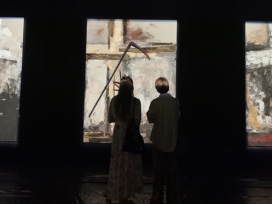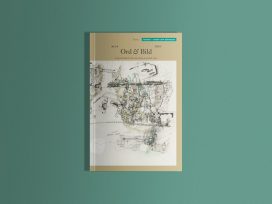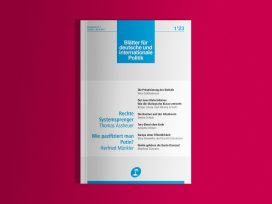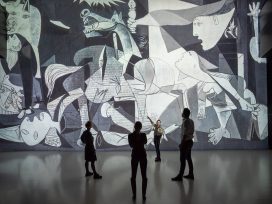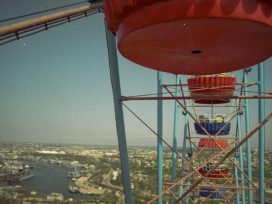Andrea Zederbauer: For thirty years, Palmyra in Syria was your field of research and the subject of your publications. In October 2010, you completed your last excavation there, a few months later the civil war broke out. In 2015, ‘Islamic State’ (IS) militias used the archaeological monuments as a stage from which to attract the attention of an international public. Propaganda videos showing the destruction of the monuments helped IS acquire a popularity that it probably lacked previously. How do you cope with this?
Andreas Schmidt-Colinet: Badly. Palmyra is reduced to dust, and you end up on television in Austria (ORF) and Germany (ARD), as well as in the New York Times. For the media, it’s about breaking news, about facts and figures, and also emotions, that’s how the system works. When a senior archaeologist was murdered, whom I knew well of course, it was put to me: ‘Khaled Asaad has been murdered. How do you feel about this?’ Which is to miss the point. The focus on the number of people shot in the theatre in Palmyra – or in Bataclan in Paris – this too represses the issue. Crucial is not whether another pillar is destroyed, or if one of the burial towers is blown up one day and the Temple of Bel the next. This is to concentrate on outward appearances and on numbers, rather like in higher education policy at universities – something I know about well, having worked as a professor for long enough.
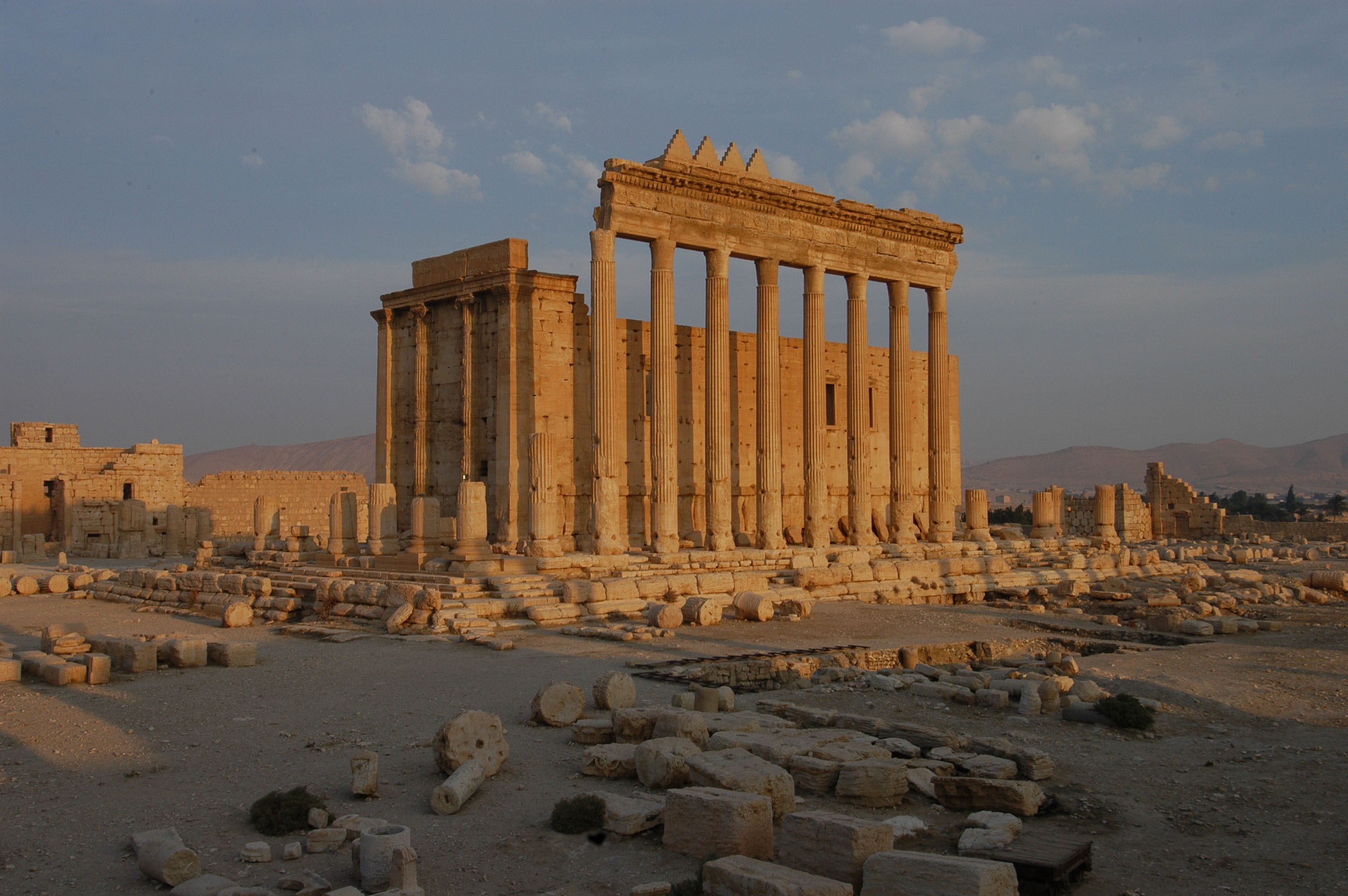
Temple of Bel, Palmyra, in 2010. Photo: Andreas Schmidt-Colinet
AZ: The sciences are neglected and smaller subjects discredited as luxuries. However, 9/11 clearly showed that the public urgently needs Orientalists, Assyriologists, Arabists, scholars of religion and so on, in order to gain a comprehensive understanding of what’s going on and to draw the right lessons.
ASC: And we in turn have the task of explaining our research to those who fund us, since our funding ultimately comes from the public purse. The public must be informed, and I have done this in lectures and publications. But to return to the point that the media is more interested in quantity than quality. Often the media doesn’t even want to know what the so-called Islamic State has destroyed. Take the Temple of Bel: imagine you have a reconstruction of the temple in front of you, then on one side you see pillars with a gable on top. What does this mean? A gable as a Greco-Roman architectural feature always indicates a sacred site, a holy place. On the long side of the temple, which according to oriental tradition is the front, you see stepped battlements on top. This is a feature from the ancient Orient that indicates a sacred space. Those who lived locally in Palmyra, as well as the resident ‘foreigners’ – Greeks and Romans – who followed the western cult tradition, both considered this temple to be theirs. It is as if the Gothic bell tower on Vienna’s St Stephen’s Cathedral were replaced by a minaret. Imagine that Muslims see St Stephen’s as being a mosque while we see it as a Christian church! This is completely unthinkable for us. But two thousand years ago in Palmyra, it was conceivable. This mixture of ancient Oriental and Greco-Roman forms can also be seen in sculpture as well as in language. From the first century before the Common Era until late antiquity, both Palmyrene and Greek were used alongside one another as written languages. We know this from inscriptions, including those on the burial towers. This only occurs here. Everywhere else in the East, local languages and inscriptions were supplanted by Greek or Latin. It is important to be aware of what was destroyed here.
AZ: How were the Palmyrenians able to achieve this?
ASC: I don’t know for sure. I can only say that this is how it was. Their clothing also indicates that they lived together with one another and alongside one another. Beautiful Parthian caftans were just as likely to be seen on the street as himations, the Greek gowns, or even Roman togas. And today, our society is preoccupied with the question of whether or not to forbid headscarves! I agree with the rejection of the burka or niqab. We need the face. The face allows us to recognize the other and has done so since antiquity. It is no coincidence that we have our faces on our passport pictures as opposed to slits revealing only our eyes or a photo of our knees. But the fuss about a headscarf? What this does is divert attention from something like the Temple of Bel and how completely different cultures and religious traditions coexisted. At this temple, sacrifices were made next to one another and even on the same altar to different gods.
AZ: Did trade encourage this tolerance and receptivity?
ASC: Definitely. Parthian ceramics were imported, for example, from the Iranians in Mesopotamia, Egyptian dates and garum (fish salt) from North Africa. Silks from an imperial Chinese workshop have been found in several tombs, some silks have epigraphs woven into them that provide us with an idea of when and where they were produced. In Plinius, you can read about the outrage caused by the chic Chinese silk outfits being worn in Rome. They reached Rome via Palmyra. Palmyra was a central location between Xi’an at the end of the Silk Road and Rome. Traders felt at home in the surroundings that had been created for them there; the colonnades for example were a Roman ‘invention’. They were a desirable western architectural form, just as today we want skyscrapers like in New York. The appropriation of such models isn’t just a trend, it also a way of showing who one is. And the colonnades and the theatre were very familiar to visitors from Rome.
AZ: What travelled in the other direction?
ASC: We know this too. In the tombs of Chinese emperors, you can find beautiful red-gloss pottery from Arezzo. Wool and Roman glass was also imported to China via Palmyra. And in the so-called Hellenistic city, we excavated a large caravan building and found olive oil from Spain. What we know remains only the tip of the iceberg; yet, from this alone, it is possible to reconstruct a global trading system. Camels were used to transport the goods across the desert, which were then loaded onto ships. This is proven by the reliefs of ships or inscriptions by a Palmyrene captain who sailed to India, crossing the Persian Gulf. For a time, this was the main route of the Silk Road.
AZ: Up until the 1920s, there was an Arab village in the vicinity of the Temple of Bel that the French resettled outside the boundaries of the excavation site and the ruins.
ASC: There was a large wall around the temple area. The shrine in the middle was an antique temple until the sixth century. There is evidence proving it to have been a Byzantine church in the sixth, seventh and early eighth centuries. There were mural paintings on the inside of the temple dating back to this time. They featured life-sized figures of saints and perhaps a seated Maria with the infant Christ on her arm. These were only visible when it had rained and the limestone was damp. From around 800 – that is, from the time of the first Arabic inscriptions – the temple was a mosque. The mihrab is carved into the temple wall inside, so that it points South. Theodor Wiegand was the first scholar to work there, from 1918, and he documented the mosque. After around 800, the village that you mention emerged within the sacred site’s enclosure wall. Up until 1928, it was filled with one-storey Arab mud huts.
AZ: The site had multiple uses, whether viewed synchronically or diachronically…
ASC: Correct. And then the French archaeologists resettled the entire village from the area of the sanctuary to an area outside the antique ruins. It is highly unlikely that one would do that now. Today the village would probably be given protected status. A completely new town was thus built, with art nouveau buildings and a beautiful town hall that was still standing up until some years ago. Of the 50,000 residents who used to live there, only around a hundred now remain. The town has been completely destroyed.
AZ: In his novel Compass, the French author and orientalist Mathias Énard writes: ‘impossible, in Paris in 1999, with a glass of champagne in hand, to imagine that Syria would be devastated by the worst violence, that the Aleppo souk would burn down, the minaret of the mosque of the Omayyads collapse, so many friends would die or be forced to go into exile; impossible even today to imagine the amplitude of the damage, the scope of this suffering from a comfortable, silent Viennese apartment.’
ASC: Everyone knew that Syria was a powder keg and, of course, the foreign embassies also had an evacuation plan in case of emergency. In the 1980s, it was feared that a situation could occur like the one in Iran. Palmyra always played a particular role in such considerations. Geopolitics renders the residents of Palmyra both a buffer and the mediators in the country. The urban cultures on or near to the western coast have a Phoenician history and Roman flavour: Damascus, Hama, Aleppo. East of there lies the desert steppe, with its Bedouin traditions. Up until the 1980s, there were no asphalt road from Palmyra to Deir ez-Zor and Upper Mesopotamia, the entire east of the country could only be reached – from Palmyra eastwards – via dirt tracks. Then, at the Euphrates, there is a thriving fertile landscape shaped by the cultivation of cotton. People have re-settled there. Up to this day, the people of Palmyra remain halfway between the two. Palmyra is Syria’s heart, it lies not only at the geographical centre of the country but also at its political centre.
AZ: Shortly after the murder of your colleague, the archaeologist Khaled Asaad, you said that you had ‘received satellite images of Palmyra from the German Aerospace Centre. In these images, you can see every pedestrian. Nobody can tell me that the military does not have better images than me, a humble professor. I cannot understand how fifty armoured vehicles can have driven two-hundred kilometres on the only proper road and everyone is surprised that IS is suddenly in Palmyra. This makes me really angry: why did no one intervene?’ Do we need UNESCO Blue Helmets?
ASC: It was at least twenty vehicles – and yes, it made me really angry. Because two days before the so-called IS marched into Palmyra, they announced on their TV station what they were about to do, which apparently no one had translated. The bearded speaker said: ‘Now we’re going to drive to Palmyra, destroy these heathen monuments, kill people in the theatre as examples, and then it’s the turn of those who take care of these idolatrous cultures.’ Ultimately, they’re not just targeting archaeologists but all of us. And what did the Security Council do? It passed a resolution stating that ‘you are not allowed to murder people’. And UNESCO said ‘that is World Heritage, you can’t destroy it’. That’s how the international community reacted to the IS announcement. So there you have your answer to the Blue Helmet question. Blue Helmets wouldn’t have done anything about it either. It would have required the UN Security Council – or a UNESCO director, who would need to be the commander of the Blue Helmets – to dispatch forces that could hinder what had been announced and what actually happened. They probably wouldn’t have done such a thing.
AZ: There is no lack of institutions then?
ASC: No. Again, it’s a question of form. You create a new military force, but that doesn’t solve the problem. I consider it a waste of money. And what is World Heritage if the World Security Council and World UNESCO stand by and do nothing?
AZ: Does World Heritage status provide protection or actually encourage ransacking and destruction?
ASC: It tends to encourage it. And it has nothing to do with culture. World Heritage status is primarily about politics and money. Talking of which, I don’t know where the World Heritage funds for Palmyra have gone since 1980, because they never arrived in Palmyra.
AZ: The German-language media in particular reported the destruction of the antique sites in 2015. At the same time, IS also blew up the prison in Tadmur, the Arabic name for Palmyra. This is something that probably had a greater effect on many Syrians, since it was where Assad had his opponents tortured in the 1980s.
ASC: For example. The media also didn’t report that IS blew up Islamic monuments in Palmyra, such as a shrine to the descendants of the Prophet up on the mountain. That was sacred to the people. IS blew it up along with old Muslim graves in the palm gardens of the oasis. Pictures of this exist too. But they weren’t shown.
AZ: I want to read you a second excerpt from Enard’s Compass: ‘Europe sapped Antiquity under the Syrians, the Iraqis, the Egyptians. Our triumphant nations appropriated the universal with their monopoly on science and archaeology, dispossessing the colonized populations by means of this pillage of a past that, as a result, they readily experienced as alien: and so brain-washed Islamist wreckers drive tractors all the more easily through ancient cities since they combine their profoundly uncultivated stupidity with the more or less widespread feeling that this heritage is an alien, retroactive emanation of foreign powers.’
ASC: Harshly formulated, but I would definitely agree with that.
AZ: In 1980, the German Archaeological Institute opened a branch in an authoritarian state…
ASC: Yes, that’s a difficult question. Does it support the regime or does it help the country, the population? The people in Palmyra were happy that we came every year. Firstly, those who worked for us could feed their families as a result. Secondly, we of course did something for the country, worked on its history, created exhibitions in the museums. French, American and English institutions had been there for some considerable time, some since the beginning of the last century. In 1980 – when Hans-Dietrich Genscher was German foreign minister – culture was very clearly used to open up politics towards the East. The embassy’s cultural department and the Goethe Institute in Damascus invested in more staff and the German Archaeological Institute wanted to set up a new operation base in an Arab country. A colleague and I set up this institute and began research and excavations in the country, always in cooperation with the Syrian Directorate General of Antiquities of course. In fact, we provided more the finances and the Syrian side provided more the infrastructure. We paid the workers, but of course Khaled Asaad selected them. This in itself was a difficult enterprise. You have to employ someone from each family, from each clan, and you need a supervisor and foreman whom everyone respects, regardless of which family and religion they belong to. Furthermore, for Khaled Assad, our joint field work and studies were an opportunity to continue studying archaeology. ‘Classical archaeology’ as such does not exist as a discipline in Syrian universities.
AZ: Your excavations have come to an end for the moment. Your current focus increasingly centres on the illegal trade in antiques, which is not in itself a new phenomenon.
ASC: Of course not, this has absolutely nothing to do with IS. There has been plundering for a long time, there were already laws in antiquity that made unauthorized excavations illegal. In theory, even our workers could be involved, as they certainly know what can be found where. We also have published our research papers, which document the artefacts found. Only through that do artefacts become collectables on the art market. Just a few years after our publication about the textiles of Palmyra, greater quantities of these textiles started appearing on the market. Archaeologists are therefore also partly responsible for this kind of thing, since they are the ones who make the information available and create the market. That is one thing. To reduce the illicit trade in antiquities is very difficult because the laws – at least in Austria and in Germany – place the burden of proof of provenance on the complainant. Unfortunately, the new German law that protects cultural property works the same way. It ought to be the other way around – the burden of proof of provenance should be on the antiquities seller or dealer. The seller must be able to present a certificate, a passport (‘pedigree’), confirming that the wares had been legally exported from Syria in accordance with the expertise of the Directorate of Antiquities or the Ministry of Culture or Tourism. The provenance of the object and the specific site it came from must be traceable. Of course, you can also forge papers. A New York auction house obviously did plant forged papers on a dealer. It is practically impossible to stop such things happening.
AZ: Is it possible to influence demand?
ASC: Yes, you can make it clear that this is theft. Indeed, in the case of Palmyra, it is not only the Syrians who are being robbed – though it is they who are being robbed primarily – but also you, me, everyone. The fact that collectors bought reliefs and suchlike in the nineteenth century, that is completely different. Today, we have a different awareness of these things, and we should sensitize ourselves so that we don’t buy these objects any more. Some years ago, I gave a lecture in Cologne. Two years later, an old gentleman contacted me. He wished to speak to me. He arrived, placed a bust of the emperor Augustus in front of me on the table and said: ‘Professor, two years ago I heard your lecture and since then, I can no longer look at this Augustus on my piano.’ Of course, I find this wonderful.
AZ: What happens in a case like this?
ASC: The bust returned to a museum in Italy. But people’s awareness will only change slowly. Collections also can be an investment, which means that the children of art collectors will sell these collections again at some time.
AZ: And if there are stolen antiquities in collections – how do you get rid of them then?
ASC: Let’s say the owner claims that he got the antique from his grandfather. Once again you have the problem of the burden of proof of origin. It may well be that the grandfather legally acquired an object in Palmyra fifty years ago and took it with him. First, you would have to prove the contrary. For example: in the large caravan building in Palmyra we discovered murals and stucco friezes. These friezes are decorated with Dionysian motives, with maenads and cantharoi (drinking cups), various kinds of fish and octopuses. In 2010, we exhibited the small stucco heads in the Museum of Palmyra and published them in 2013. Such decorative pieces from Palmyra were previously unknown. No one could have purchased them as collector’s items fifty years ago, because they first came to light through our dig. In 2014, several such small stucco heads appeared for four or five hundred euros each in a German gallery. They were described as being ‘from Palmyra’ and as having long been in the possession of an old Bavarian family. This lacks all credibility, but the police would have to prove otherwise. The law lags behind in this respect.
AZ: For some time now, there has been talk about reconstructing antique sites destroyed by IS. The German art historian Horst Bredekamp has spoken of ‘combative reconstruction’. In his opinion, the art of reconstruction must triumph over the destruction wrought by IS: as a show of resistance against its iconoclasm.
ASC: There is a neo-colonial undertone in this discussion that I don’t like at all. According to this argument, it is the temples excavated by ‘our’ archaeologists for ‘our’ tourism that are supposed to be reconstructed. In a sense, we have prepared a skeleton – for example the Temple of Bel in its 2015 state – and put it on display. And it is above all the West and its scholars that have done this. Today, neither archaeologists nor any institution responsible for cultural heritage would do it the same way. To then speak of reconstructing the temple is in some way perverse. This will not return the skeleton to life. No. I think, we should do absolutely nothing! We can only make suggestions, perhaps create 3D animations, but above all, we can provide funding and perhaps specialized personnel.
But first, precise records have to be made of everything, and the destruction must be recorded exhaustively. We archaeologists know how to create detailed architectural documentation of a destroyed building and how to reconstruct a temple or to rebuild it. It will take years just to identify all the stones that are lying there. Furthermore, why should one rebuild the temple as it looked between 1929 and 2015? That was the shortest phase of its life. During the longest phase, it was a mosque. One could leave the ruins as they are today. One could even carry out more excavations. We know that the temple had a forerunner and that it stands on a prehistoric dwelling mound (‘Tell’). How did it come to pass that a temple was built there in Roman times, in 32 after Christ? What was there before?
All these considerations could be taken in account when developing a modern visitor centre. Various techniques could enable visitors to get an idea of the history of this sacred site; it would also be where the Byzantine murals and the Islamic mosque are shown. There are records of how this area looked in the eighteenth, nineteenth and early twentieth centuries, and how people lived there. One could raise awareness of how problematic the archaeologists’ appropriation and the destruction of the Arab village was, almost a hundred years ago. This destruction is a warning. A hundred years later, we would no longer do it the same way.
And we shouldn’t build anything that cannot be reversed in another hundred years’ time. The Arab village cannot be reconstructed, it’s gone. Not to destroy but to narrate history, I consider this to be both our duty as well as a very stimulating task. This way, one also does something for the residents. Bear in mind that Greek and Roman history is scarcely taught in Syria. History classes begin in Ancient Mesopotamia, proceed to the New Assyrian empire, the Persians and to Alexander the Great. It only really begins again in the seventh century with Mohammed. This means that the historical background and the importance of the major ruins and monuments of the Greco-Roman period – Apamea, Palmyra, the theatre in Bostra, the main tourist attractions – are not really taught in schools.
I would respond to Bredekamp by making the comparison between Warsaw and the Frauenkirche in Dresden after World War II. After 1945, the citizens of Warsaw decided to start rebuilding their city immediately. They reconstructed it in a historicizing manner. This may seem unemotional to us, but the people of Warsaw wanted it that way – which is well and good. In contrast, the rebuilding of Dresden’s Frauenkirche took decades. The decision to rebuild it together with the planning phase was a long process that was not initiated and influenced by the Allies, but by the citizens of Dresden. What first must be rebuilt in Palmyra is the modern city, an essential infrastructure, houses, flats, a water system – there has been no electricity and no running water for several years – a nursery school, a school, a hospital, a mosque, a cemetery. Above all, people have to go back there: human beings have to return to their houses. And then you can consider whether and how you rebuild the Temple of Bel. And these decisions must be taken by those who, hopefully, will one day live there again peacefully.

